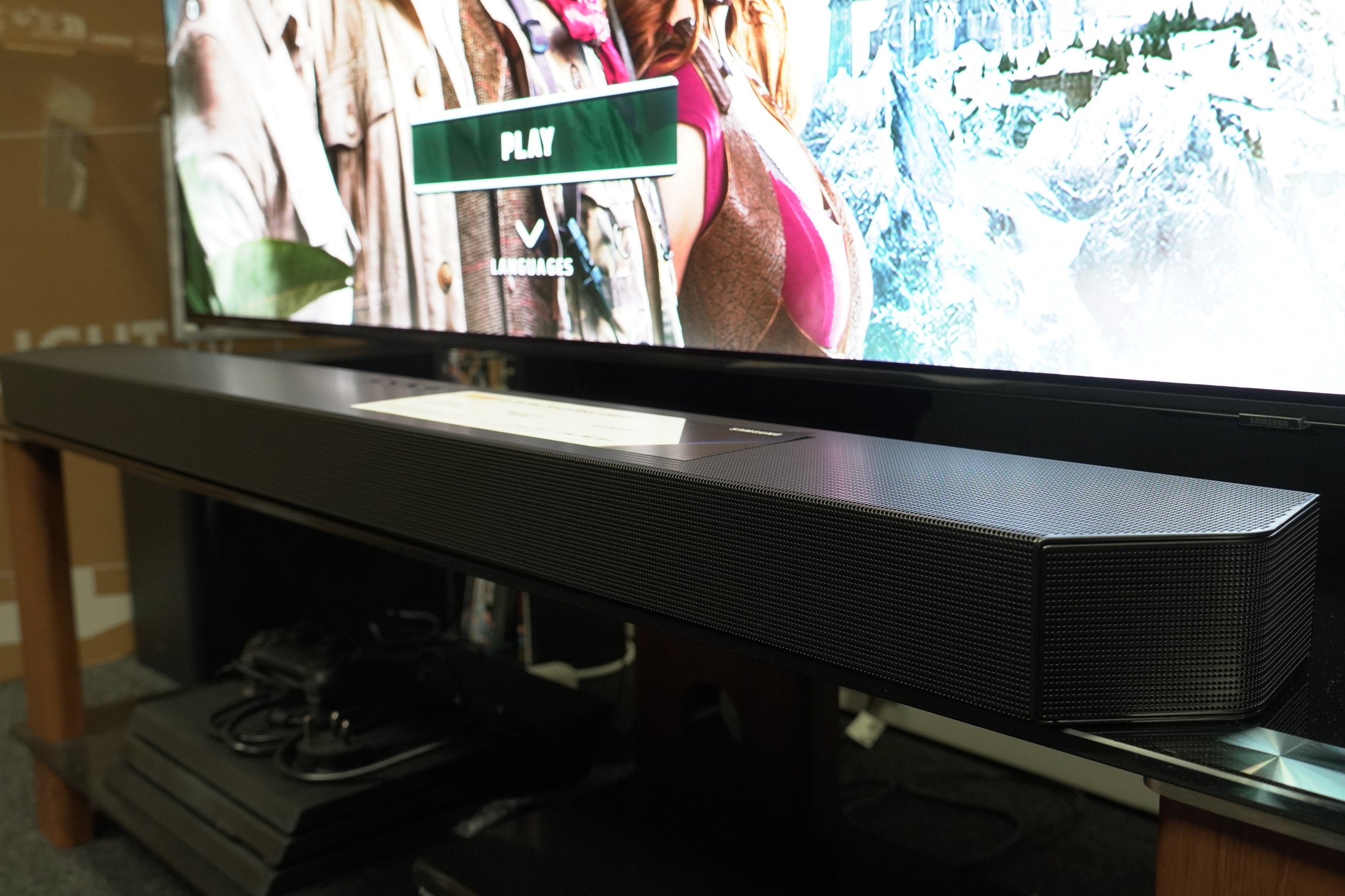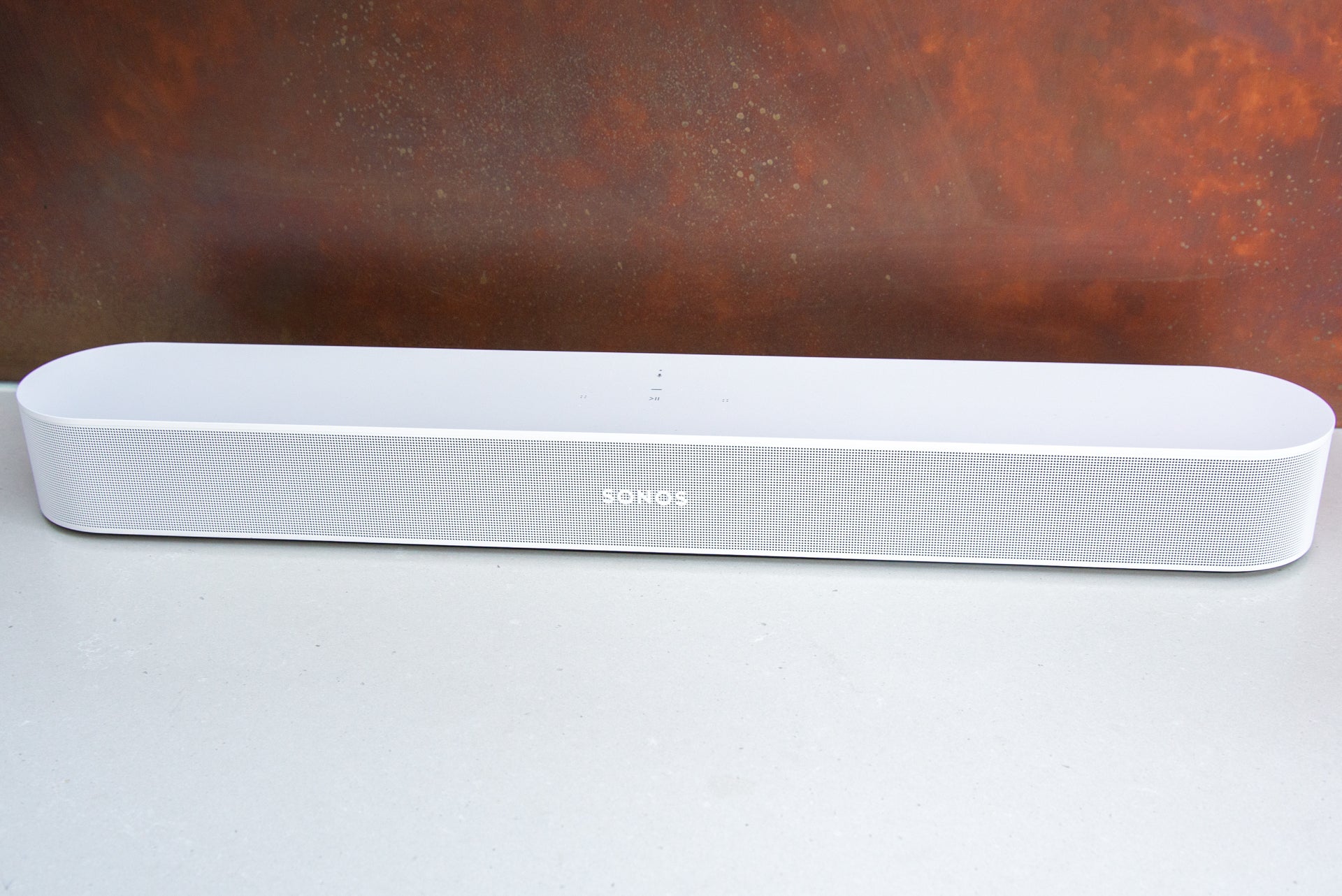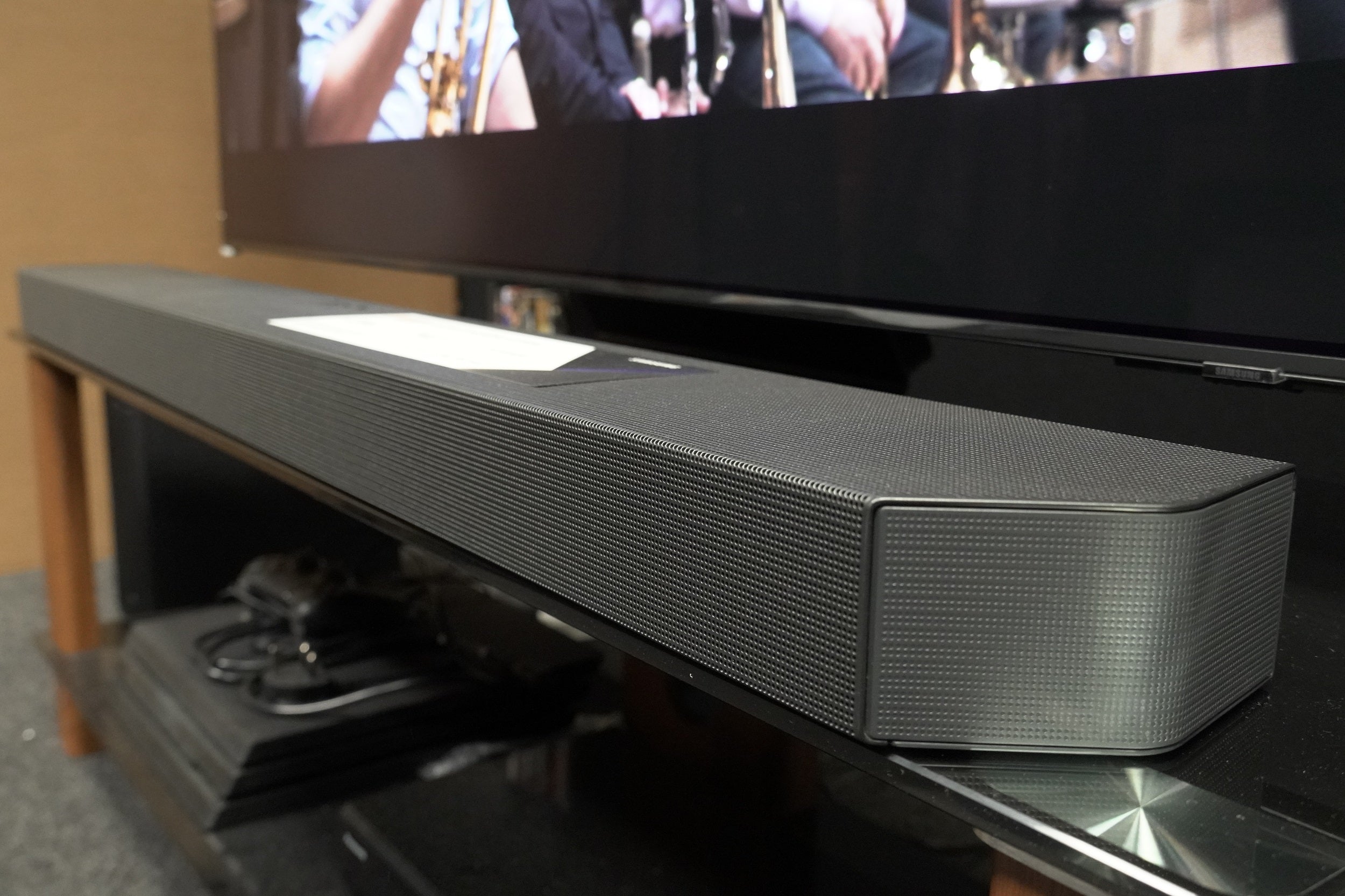Samsung HW-Q990B Review
A 16-channel soundbar that takes Dolby Atmos soundtracks to a whole new level


Verdict
When it comes to providing an epic, high quality sound experience for movies and TV shows, there’s simply no soundbar system better than the Samsung HW-Q990B. When dealing with stereo music, the returns aren’t as high, with a bass performance that feels detached from the rest of the frequency range.
Pros
- Delivers a true surround sound experience
- Outstanding Dolby Atmos performance
- Two HDMI inputs
Cons
- More clutter than a single-bar solution
- No 4K 120Hz pass-through
- Music doesn’t sound as good as movies
Availability
- UKRRP: £1299
- USARRP: $1499
- EuropeRRP: €990
- AustraliaRRP: AU$1399
Key Features
- Four wireless componentsShips with two wireless rears and a wireless subwoofer to go with the main bar
- Dolby Atmos and DTS:X playbackSupports object based sound formats from Dolby and DTS
- Q Symphony supportJoins forces with compatible Samsung TVs to deliver a bigger, more detailed soundstage.
- 11.1.4 channels of sound16-channels of sound
- 656W of powerThis is a very high amount of power by soundbar standards, and ensures that all of the Q990B’s channels have plenty of power to feed off.
Introduction
Samsung’s flagship soundbar every year can usually be depended on to do two things: 1) Deliver a new record-breaking number of real sound channels for enhanced playback of Dolby Atmos and DTS:X film soundtracks, and 2) create the all-round most immersive and powerful audio performance the soundbar world has to offer.
With the Samsung HW-Q990B, though, only one of these things is true – so does that make it less of an upgrade?
Design
- Four piece solution
- Grilled metallic finish
- HDMI loop through with two inputs
The Samsung Q990B pushes the definition of a soundbar to its limit by consisting of four separate components. Namely the main 1232(w) x 69.5(h) x 138(h)mm soundbar that sits under your TV, two compact but channel-rich wireless rear speakers, and a large (220 x 413 x 410mm) subwoofer boasting a meaty eight-inch driver on its side.
The main bar and rears see Samsung ditching the felt finishes it’s used on its flagship soundbars such as the HW-Q950A in favour of a return to a more traditional metallic mesh finish. This perhaps doesn’t look as premium, but I actually prefer the Q990B’s more industrial approach. It’s far less prone to attracting dust than the felt finishes were, too.
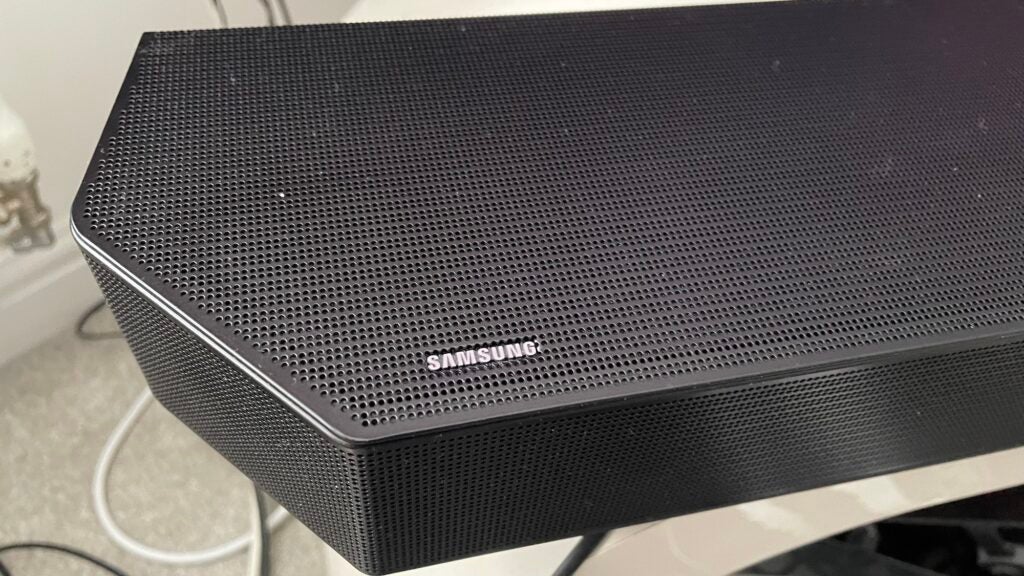
The main bar is slim enough to fit under most TVs without impacting their pictures or IR receptors, while the rears are small enough to easily tuck on a bookshelf or sideboard. The rears sit on little plinth feet, too, to isolate their vibrations from whatever furniture they’re sat on, while their top edges now angle forward slightly to, presumably, improve the sensation that overhead sounds are coming from above.
The subwoofer is more of an eye sore than the other speakers in the Samsung Q990B package, but provided you can leave its side driver unobstructed the non-directionality of its sound means you can hide it down the side of or behind a sofa, or under a sideboard. The sub includes a cool new design feature, too, in the shape of an Acoustic Lens that sits around an inch above the driver to help bass rumbles spread further and sound smoother.
The Q990B carries a reasonably bright and clear LED display to help you track inputs, volume levels, sound formats and so on, and mercifully Samsung has put this on the soundbar’s front this year, where you can see it when seated, rather than continuing to put it on the top edge as has been the case for the brand’s past couple of flagship soundbar generations.
The top edge still plays host to a series of tidy control buttons, though for most of the time you’ll be controlling the soundbar via its compact, rather lightweight but actually very easy to use remote control.
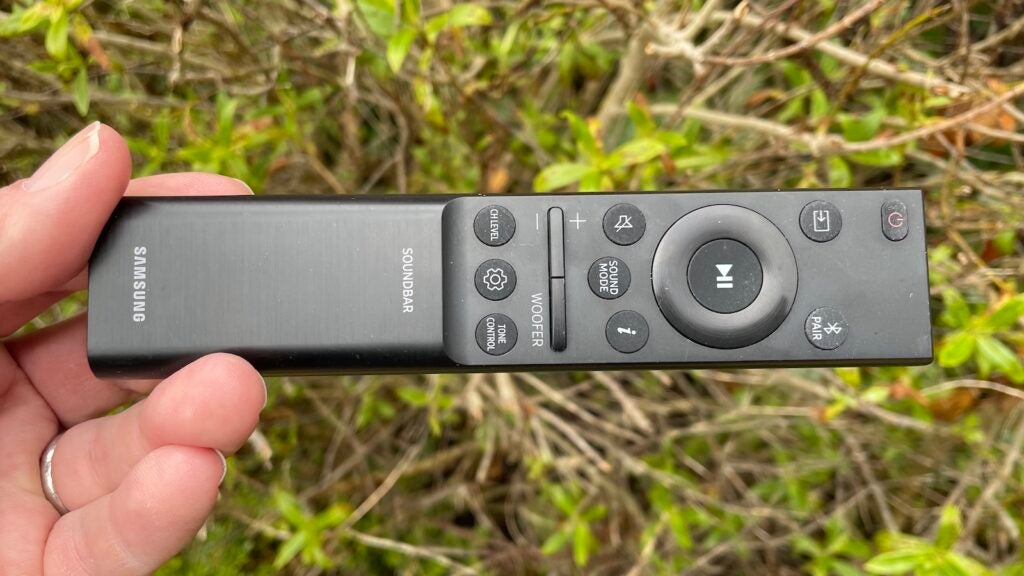
Connections are found in a bay cut out of the soundbar’s bottom rear edge, and comprise an HDMI loop-through with two HDMI inputs, plus a single optical audio input. The HDMI support includes eARC for lossless reception of Dolby Atmos or DTS:X soundtracks from compatible TVs, and there’s pass through support for all the main high dynamic range formats, including Dolby Vision, even though Samsung still doesn’t support Dolby Vision on any of its TVs.
There’s no support for 4K/120Hz and variable refresh rate gaming signals through the HDMI loop through, but to be fair very few other soundbars support this either. Gamers still have the option of connecting their consoles or PCs directly to a suitable capable TV and then outputting lossless sound from the TV to the Q990B using eARC.
Features
- Dolby Atmos and DTS:X support
- 11.1.4 channels of sound
- Wireless and Bluetooth playback
The headline grabbing feature of the Q990B is its huge 11.1.4 channel count. To be clear, these channels are all real with their own dedicated drivers – there are no virtual channels created by psycho-acoustic processing. The only soundbars able to match this huge channel count are JBL’s Bar 1300 and the Q990B’s predecessor, the Q950A.
This latter point is important because, as noted earlier, it means that for the first time for a few generations, the Q990B doesn’t add to its predecessor’s channel count. So the Q990B will have to rely on other improvements to for signs of progress.
If you’re wondering what all those channel numbers mean in sound terms, you get front centre, front left/right, side left/right, forward side left/right, rear front left/right, rear side left/right, subwoofer bass channel, and four up-firing drivers for height/overhead effects.
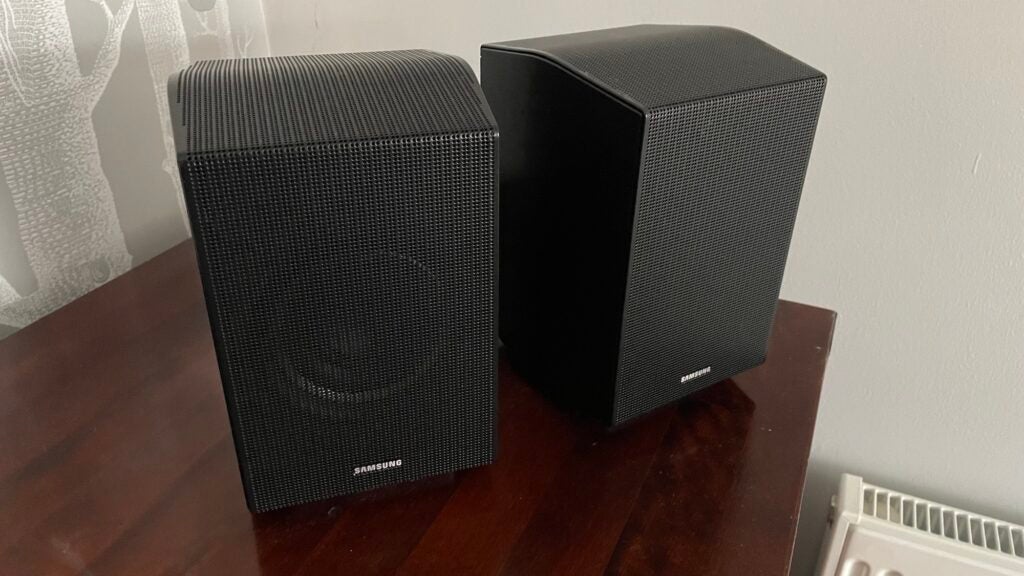
Two of these up-firers are found in the main bar, while each rear speaker also sports one on their top edges. The rears also each carry a side firing driver as well as front-facing drivers in a bid to deliver as seamless a hemisphere of sound around the listener as possible.
It’s possible to enjoy wireless transmission of Dolby Atmos signals from one of Samsung’s recent TVs to the Q990B – though note that this is only possible with the lossy Dolby Digital+ Atmos carrier format, not the lossless True HD one.
While I’m on the subject of benefits gained from running the Q990B with a Samsung TV, a Q Symphony feature enables the TV’s speakers to join forces with those of the soundbar to create a more detailed sound stage with better centre channel effect placement.
There’s an advantage to using the Q990B with a Samsung Galaxy phone, in that you can get the two devices talking to each other for sharing music content simply by tapping the phone against the soundbar’s bodywork.
Bluetooth and Wi-Fi connectivity is also available, with support for the Alexa voice recognition system built in, and streaming possible using AirPlay 2 and Spotify Connect. File types supported included the AAC, WAV, FLAC, AIFF, OGG and ALAC high resolution formats.
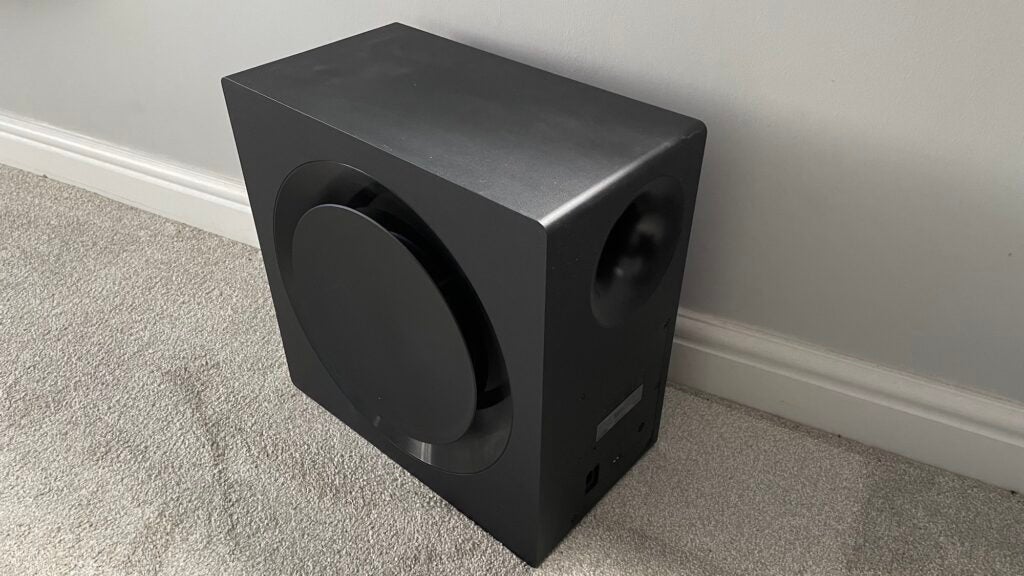
Set up and day to day use of the Q990B is possible via Samsung’s reasonably useful SmartThings app for a more detailed and visual control system than the remote control/LED display combination can provide.
Options within the app include SpaceFit, which is the rather sci-fi name for an auto-calibration system that uses mics in the main soundbar to assess and compensate for room acoustics. Unlike cheaper soundbars in Samsung’s range, the Q990B additionally gets an Auto EQ system for monitoring and continually adjusting the subwoofer’s bass output to keep everything in balance.
Other features include an Active Voice Amplifier that can sense when there’s lots of ambient noise around and elevate vocals in a sound mix to compensate, and an Adaptive sound mode that essentially remasters stereo music tracks to take advantage of the Q990B’s huge number of channels.
Sound Quality
- Fantastically immersive sound staging
- Huge power and dynamics
- Improved music performance
For my money, there’s currently no other soundbar out there that delivers a more fully formed and immersive Dolby Atmos soundstage than the Samsung HW-Q990B.
Not only can I make out and fully appreciate every last one of its 11.1.4 channels, but they all join forces brilliantly to create a pretty much flawless hemisphere of sound around my seating position. An immersive three-dimensional surround sound space, that’s packed with immaculately balanced, pristinely clear and perfectly placed details.
Plenty of soundbars can create a good sense of space in front of the listener, and a few can even add a convincing sense of height above and behind. But none I have heard can create that all-important Dolby Atmos (and DTS:X) sound bubble quite as well as the Q990B.

The improved rear speaker design means the up-firing sounds from the front and back meet up with each other over the head more cleanly and effectively, while the side firing drivers on the rears also blend better with the front-side drivers on the main bar, closing any distracting ‘gaps’ in the almost uncannily three-dimensional soundstage.
The rear speaker channels blend well with the sound from the main bar, too, despite their relatively petite dimensions, ensuring that front to back and side to side transitions always sound convincing.
Vocals sound clear and rich, but never so much that they become dislocated from their soundtrack surroundings, and they also appear slightly raised vertically to make them seem better attached to the onscreen action.
While the Q990B has the power to create a huge, room-filling sound stage without losing cohesion, it’s also sensitive enough to populate its sonic space with even the smallest of soundtrack details, ensuring that good movie mixes are as busy and involving as they are spacious and aggressive.
Talking of aggression, the Q990B’s ability to respond to sudden hard or highly dynamic impact sounds is stunning, enabling it to bring more grit and intensity to even the densest and most explosive movie moments than any other soundbar in its class.
The main soundbar is capable of producing a bigger and more expressive dynamic range than the vast majority of standalone soundbars can – but in the Q990B’s case, there’s an unusually large subwoofer to flesh out the lower frequency range, leaving the main bar freer to focus on the mid-range and treble details without either sounding in the least bit compressed, thin or congested.
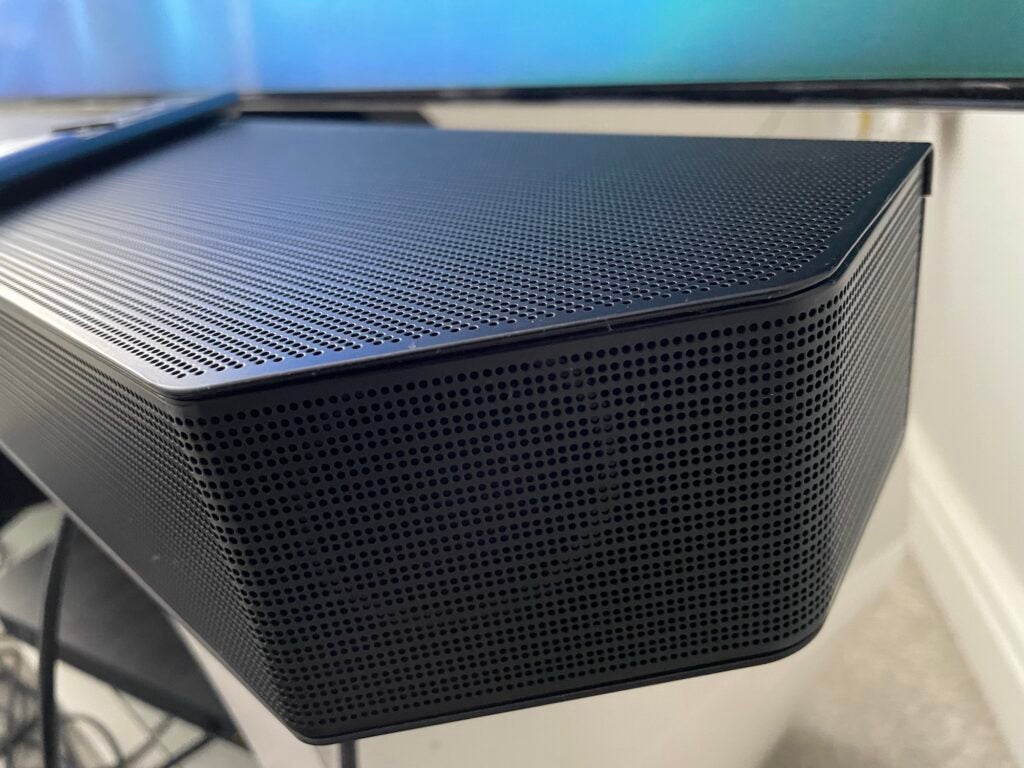
The subwoofer’s new Acoustic Lens attachment helps it deliver the sort of mammoth but also nimble and expressive bass levels I’m accustomed to hearing from Samsung’s flagship soundbars with more smoothness and consistency, ensuring that while low frequencies continue to be cinematic and present to a degree rarely heard in the soundbar world, they also blend better with the overall sound stage and attach more invisibly to the lowest frequencies from the main bar.
Add to all this the way the new rears are less likely to trigger audio coloration from the surface they’re placed on, and the way the auto-calibration system does a great job of harmonising the Q990B’s many components with little or no manual input, and it’s seriously hard to find anything to complain about when it comes to movie soundtracks.
Things aren’t quite as clear cut with music. Starting out on a positive note, Samsung has managed to substantially improve its latest Adaptive Sound mode for remixing stereo music to take advantage of the Q990B’s expansive channel roster. So intelligently are the elements of a stereo mix rearranged into the soundbar’s various channels, including the rears, that I often found myself thinking I must have accidentally put on a Dolby Atmos track by mistake.
This level of musical understanding when it comes to deciding what elements of a stereo mix can go where in a surround remix is backed up, too, by much more careful balancing of a track’s vocals, beats, guitars/strings and percussion than I’ve heard with similar modes on previous Samsung soundbar modes. This is especially true when it comes to vocals and bass, with the former tending to retain better and more consistent prominence in the remix process, and bass remaining present and responsive but now being less inclined to become too dominant.
The Adaptive mode can sound a bit forced or struggle to make the right channel placement choices with very dense music, especially guitar-led rock, and of course, it won’t appeal at all to hi-fi purists. While the Q990B can sound pleasing enough with relatively basic, sparse stereo music mixes, though, with denser fare its subwoofer’s bass input can sometimes sound distractingly detached from the rest of a mix, while other mix elements can start to sound slightly muddy and cluttered in a way that simply never happens with films.
Latest deals
Should you buy it?
Uniquely compelling Dolby Atmos performance: No other soundbar I’ve heard does as good job of creating the immersive Dolby Atmos sound bubble.
Music is your main motivation: The Q990B’s movie talents perhaps come at the expense of musicality and balance with stereo music. Though if you’re not a purist, the Adaptive sound remix mode is cleverer and more listenable with most music types than previous iterations.
Final Thoughts
While its movie prowess maybe hurts its (stereo) music performance a little, there’s simply no better everything-included soundbar out there when it comes to the main soundbar business of turning film and TV show soundtracks into epic, immersive home cinema experiences packed with detail, power and dynamism. All of which makes its price look pretty agreeable, too.
How we test
We test every soundbar we review thoroughly over an extended period of time. We use industry standard tests to compare features properly. We’ll always tell you what we find. We never, ever, accept money to review a product.
Find out more about how we test in our ethics policy.
Tested with real world use
Tested for several weeks
FAQs
These are so-called object-based sound formats that create a three-dimensional soundstage around the listener into which effects are placed – rather than just reproducing sounds that seem to be coming from your speakers as happens with normal surround sound systems.
High resolution audio refers to high-bandwidth file formats capable of delivering music in much higher quality, with much less compression, than regular audio file formats.
Yes. Apart from each component needing its own power cable, they all communicate with each other as a system without any need for cables between them.



